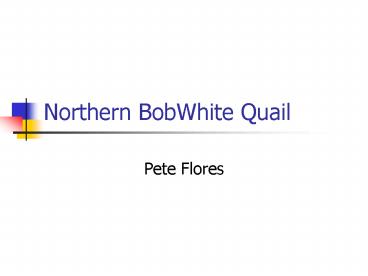Northern BobWhite Quail PowerPoint PPT Presentation
Title: Northern BobWhite Quail
1
Northern BobWhite Quail
- Pete Flores
2
General Information
The northern bobwhite, commonly referred to as
bobwhite quail, has long been a favorite gamebird
throughout the eastern United States, and is a
welcomed upland ground dweller on farms and rural
landscapes with its infamous call of bob-white!
Highly social and displaying gregarious activity
nearly year-round, bobwhites thrive in an array
of varying early successional habitats. Its
affinity for a variety of early successional
communities makes the bobwhite both unique and
fairly manageable
3
Habitat Requirements
Quail occupy a wide variety of early successional
habitats, including active and fallow crop
fields, pastures, old fields, native grasslands,
hedgerows, brushy fencerows, woodlands with grass
and forb ground cover, open meadows with a shrub
or brushy component, cut-over timber-lands,
roadway and powerline rights-of-way, wooded
riparian areas, brushy canyons and hillsides, and
rural residential areas. The role of regular
habitat disturbance in maintaining productive
bobwhite habitat is extremely important.
Disturbances, such as fire, timber harvest,
grazing, and disking, are necessary to maintain
the early successional
4
Brood-rearing Cover
Brood-rearing cover differs from nesting cover
because it is generally more open at ground level
to enable movement of quail chicks. As much as 70
percent of brood-rearing cover can be open, bare
ground. Whereas good nesting habitat has
generally not been disturbed for two or three
growing seasons, the best brood habitat occurs
within the first year following disturbance of an
area through burning, disking, timber harvest, or
other means. Overhead concealment, diversity of
low-growing green foliage, and abundant insects
are required brood-rearing cover characteristics.
Recently burned grasslands, old field
communities, weedy field borders, legume
plantings, and small grain fields provide good
brood-rearing cover.
PowerShow.com is a leading presentation sharing website. It has millions of presentations already uploaded and available with 1,000s more being uploaded by its users every day. Whatever your area of interest, here you’ll be able to find and view presentations you’ll love and possibly download. And, best of all, it is completely free and easy to use.
You might even have a presentation you’d like to share with others. If so, just upload it to PowerShow.com. We’ll convert it to an HTML5 slideshow that includes all the media types you’ve already added: audio, video, music, pictures, animations and transition effects. Then you can share it with your target audience as well as PowerShow.com’s millions of monthly visitors. And, again, it’s all free.
About the Developers
PowerShow.com is brought to you by CrystalGraphics, the award-winning developer and market-leading publisher of rich-media enhancement products for presentations. Our product offerings include millions of PowerPoint templates, diagrams, animated 3D characters and more.

